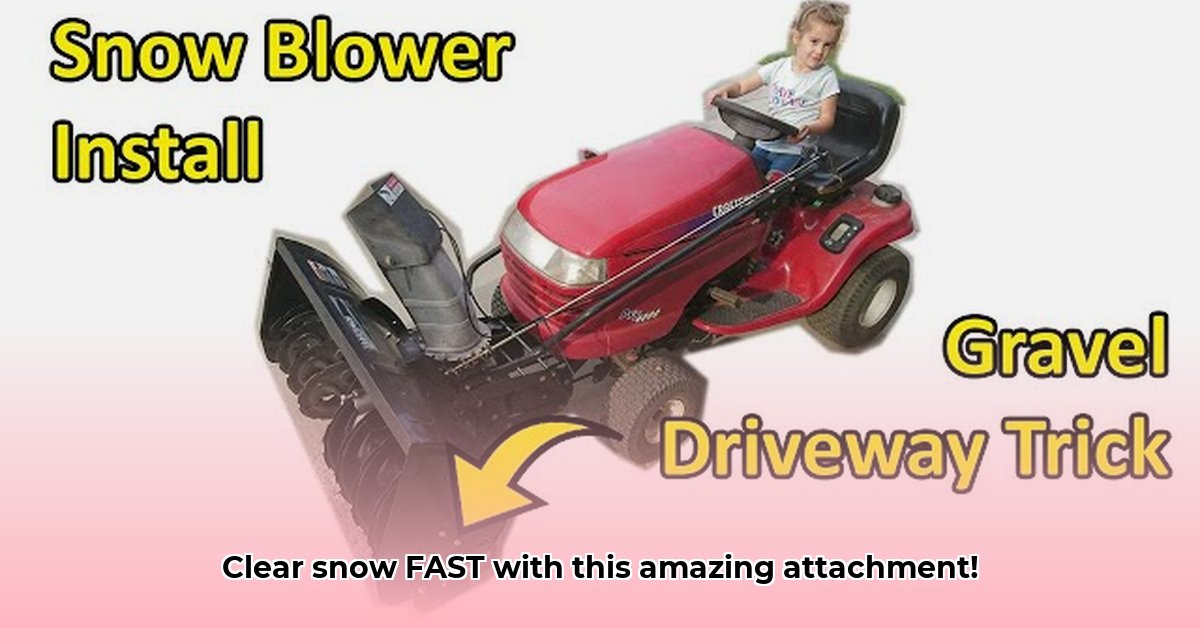
This comprehensive guide helps you conquer winter's worst with your Craftsman snowblower attachment. We'll cover installation, operation, maintenance, and offer crucial buying advice based on compatibility and performance. For more information on tractor snowblower attachments, check out this helpful resource.
Installing Your Craftsman Snowblower: A Step-by-Step Guide
Attaching your Craftsman snowblower is straightforward but requires precision. Always consult your owner's manual for model-specific instructions. Safety is paramount; ensure your tractor is turned off and the parking brake is engaged before proceeding.
Preparation: Ensure the tractor is off, the PTO (power take-off) is disengaged, and the area is level.
Alignment: Carefully align the snowblower's mounting brackets with your tractor's hitch. A snug fit is key; forcing anything can damage components.
Secure the Connection: Use the provided bolts and pins to firmly attach the snowblower. Double-check that all fasteners are securely tightened to the manufacturer's specifications. Overtightening can be detrimental.
Hydraulics (if applicable): If your model uses hydraulics, connect the lines and engage the levers as instructed in your owner's manual.
PTO Engagement: Carefully engage the PTO shaft, remembering that this powers the snowblower.
Test Run: Start the engine and perform a low-speed test run to ensure everything functions correctly before tackling heavy snow.
Operating Your Craftsman Snowblower: Tips for Safe and Effective Snow Removal
Operating your snowblower is intuitive, yet safety precautions are critical.
Start Slow: Begin at a low speed to gain control and familiarity. Gradually increase speed as needed, keeping a safe distance from obstacles.
Chute Adjustment: Use the adjustable chute to control snow direction. Aim away from people, buildings, and vehicles. Adjust as needed to account for wind.
Height Control: Adjust the snowblower's height to match the snow depth. Setting it too low can damage the auger; setting it too high reduces efficiency.
Clogs: Should the auger clog, immediately stop the PTO and use the provided clearing tool. Never reach into moving parts.
Belt Slippage: Belt slippage indicates potential issues. Inspect the condition and tension of the drive belt and replace if necessary. Regular inspection prevents unexpected breakdowns.
Maintaining Your Craftsman Snowblower: A Crucial Step for Longevity
Regular maintenance is vital for optimal performance and a longer lifespan.
Before Each Use: Visually inspect belts, chains, and the auger for signs of wear. This proactive approach helps prevent serious issues.
After Each Use: Thoroughly clean the snowblower, removing all snow and ice. Proper cleaning prevents corrosion and buildup.
Seasonal Maintenance (Fall/Spring): Lubricate moving parts according to the manufacturer's recommendations. Inspect and replace worn belts, chains, or other components. Consult your owner's manual for specifics.
Parts Availability: Locate replacement parts through your owner's manual or a Craftsman dealer.
Understanding Craftsman Snowblower Compatibility: Essential Considerations
Compatibility is critical. The Craftsman 42-inch snow thrower horsepower requirements vary considerably depending on the tractor's model and age. While not explicitly stated by Craftsman, the tractor's serial number (often found on a sticker) is key for correct snow thrower matching. Consult owner's manuals, online resources, and Craftsman's website for compatibility confirmation.
Have you checked your tractor's serial number for a compatible snowblower model? This simple step saves you time and potential frustration.
Pros and Cons of the Craftsman 42-Inch Snow Thrower
This table summarizes advantages and drawbacks.
| Pros | Cons |
|---|---|
| Dual-stage operation | Compatibility limitations with certain tractor models |
| Adjustable chute | May require additional weights or chains for optimal performance in heavy snow |
| Relatively easy installation & operation | Parts availability might vary depending on the snow thrower's age |
| "Made in the USA with Global Materials" (Details require verification) | Lack of explicitly stated snow-throwing capacity data |
Choosing the Right Tractor and Snowblower: Making an Informed Purchase Decision
Selecting the right equipment involves careful consideration of your needs and local conditions.
Assess your Driveway: The size of your driveway dictates the necessary thrower capacity.
Account for Snowfall: Heavy, wet snow requires a more powerful tractor-snowblower combination.
Consider Your Physical Abilities: Choose equipment you can safely operate.
Consult an Expert: Don't hesitate to ask equipment dealers for personalized recommendations tailored to your situation and location.
Did you know that local climate significantly impacts the required horsepower for snow removal? This underscores the importance of consulting local experts for advice.
This thorough guide empowers you to make the best decision for your snow removal needs. Remember, proper installation, operation, and maintenance are key to successfully conquering winter's challenges.